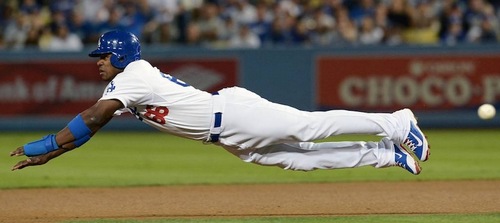The Wild Horse
 Most baseball players round the bases in a conservative fashion. If they hit the ball out of the infield they stop at first, if they hit the ball to the wall they stop at second. This is a safe way to play precisely because you're not testing your luck. Once you hit the ball, everyone knows where you'll end up and it usually isn't challenged.
Most baseball players round the bases in a conservative fashion. If they hit the ball out of the infield they stop at first, if they hit the ball to the wall they stop at second. This is a safe way to play precisely because you're not testing your luck. Once you hit the ball, everyone knows where you'll end up and it usually isn't challenged.
Another way to play is like Yasiel Puig of the Los Angeles Dodgers, the most exciting player in baseball. Although he is a great hitter who can bat for power, Puig has a very high risk tolerance and tries to make the most out of every single ball he hits.
Whereas of players who hit a ball on the ground to the outfield jog to first base and take a single, Puig views this approach as simply unacceptable. As soon as Puig is out of the batters box, he's constantly judging the defense and the likelihood that he can take an extra base without being tagged out. He's trying to force the defense to make a sloppy move and take advantage of it . Such behavior has led long time LA Dodgers announcer Vin Scully to nickname Puig "The Wild Horse".
Let's use a very simple model for baserunning:
- At each base Puig runs to, there is some probability that the defense makes the play without error and gets him out.
- Likewise, there is a chance that the defense messes up, and Puig make it to the base safely.
- The opposing team's defensive performance is characterized solely by the parameter .
Consider Puig's fortune when, on the way to first base, he decides to try for a triple. No matter what happens on the field, he's just going to keep running until he gets to third. At each base along the way (first base, second base, and third base) the defense has a chance to get him out.
Question : At what level of defensive performance, , does it become more likely for Puig to arrive at third safely than it is for him to be tagged out at some point along the way?
Note
- An equivalent question is, when does it become more likely that a cricket batsmen makes three runs than it is for him to be run out along the way?
The answer is 0.206299.
This section requires Javascript.
You are seeing this because something didn't load right. We suggest you, (a) try
refreshing the page, (b) enabling javascript if it is disabled on your browser and,
finally, (c)
loading the
non-javascript version of this page
. We're sorry about the hassle.
Pretty simple question from a very complicated situation. I just need (1-p)^3=.5. That is the point when I have a 50% chance of arriving safely.
So, 1-p=(1/2)^(1/3) and p=.2063
On a side note, I really don't like the question. Too much trying to make it relate to baseball when the probabilities are NOT the same for each base in reality.